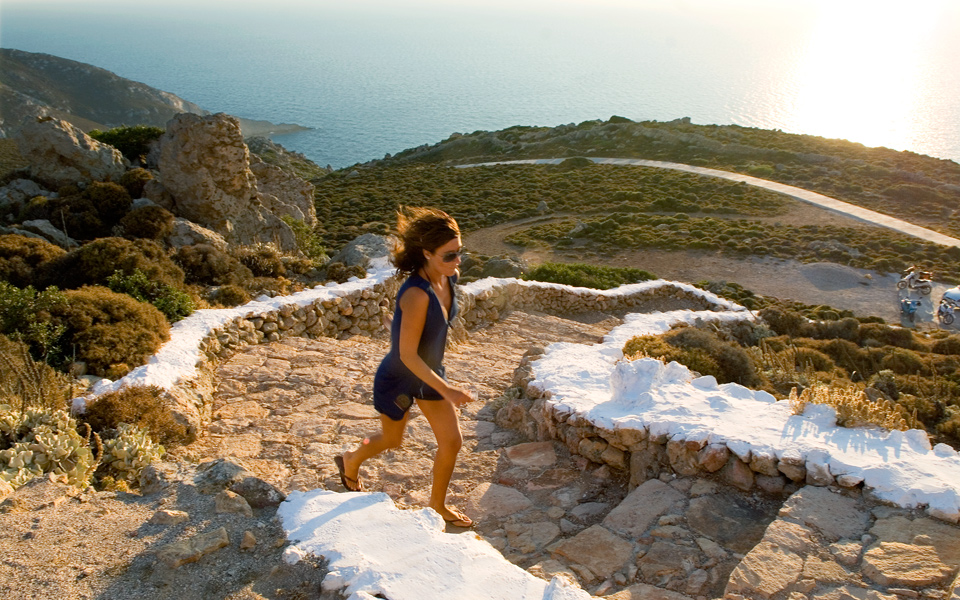The overall atmosphere on Patmos is at once cosmopolitan and discreet, a unique combination. Neither arrogant nor pretentious, this must-see island offers carefree ways, late nights and plenty of music, often quite loud around the port area of Skala. Chora, the island’s main town, has an air of mystery about it, while the island’s churches and monasteries testify to its devoutness and the beaches of Patmos are perfect for careless and relaxed fun.

© Julia Klimi
Stroll around the main town’s alleys. The architecture on view here is stunning and the mansions are unique. Visitors are bound to be captivated by architectural details such as the vaulted arches through which the town’s winding alleys pass; by buildings like the neoclassical town hall, dating back to 1870; and by the quaint town squares. The town of Chora, which sprang up around the Monastery of Aghios Ioannis Theologos, features houses that have maintained many elements typical of Byzantine-era homes, such as cisterns and courtyards. The Nikolaidis Mansion, open to the public, is a great example of such a structure. Strolling through the alleys is a little like traveling back in time to the 16th and 17th centuries, when many of Chora’s houses were built. The music, kept low at the bars and tavernas, helps preserve the main town’s refined quality, offering a pleasantly sociable atmosphere.

© Shutterstock

© Julia Klimi

A visit to the monastery, whose dress code requires women to wear long skirts, is highly recommended. This holy building sits imposingly at the top of Chora, like a castle. It should be noted that it was on this island that St. John the Evangelist wrote the Book of Revelation (also known as the Book of the Apocalypse). Upon entering the 11th-century castle, visitors are immediately immersed into the Byzantine era. Avid readers will find the library that is maintained here absolutely fascinating. After visiting the monastery, many people carry on to the Cave of the Apocalypse, situated halfway up the mountain, along the road between Chora and the village of Skala. There are other monasteries on the island that are also worth exploring, too.
Keep in mind the beaches of Psili Ammos and Lambi, just two of the many wonderful beaches that contribute to the island’s beauty and uniqueness. Lambi features colored spiral-shaped pebbles that glitter under the sun. Just one small taverna operates at Psili Ammos, a spot of exotic beauty. This beach may be reached either by boat or by a half-hour trail walk from Diakofti. Other swimming spots offering facilities include Petra Beach with its large white pebbles; the well-known Agriolivadi, featuring a number of tavernas, beach bars and water sports; and the quieter options of Apollou and Grikos.
GETTING THERE
Patmos may be reached by ferry boat from Piraeus (8 hours/€80 roundtrip) or from Kavala in northern Greece (17 hours/€120 roundtrip).

© Julia Klimi
Visit the nearby islets of Arkoi and Marathi, havens of tranquility and natural beauty. Both are administered by the Patmos municipality. A day-trip to Arkoi, which begins with a departure from the port of Patmos, may be easily arranged. This islet offers clear blue waters for swimming and fresh grilled fish by the beach. Limited accommodation is offered at both Arkoi and Marathi for those wishing to stay overnight.
Make a note of the Patmos International Film Festival, which will be held from July 25 to July 30, 2017. The festival, which aims to promote alternative tourism, offers film screenings, workshops, seminars and a short film competition. The laid-back bars in Chora, which are open until late, can be relied on to provide festival-goers with plenty of follow-up entertainment. Also look out for galleries, workshops and stores offering functional art objects for sale. Keep an eye out, too, for the Religious Music Festival, held on Patmos from the end of August, 2017.












